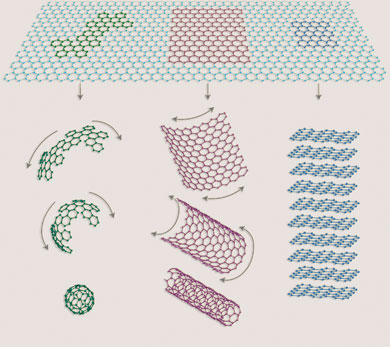Graphene: Thin is In! (Nobel Prize in Physics 2010)

It is the thinnest material ever created, yet its wondrous properties will have a tremendous impact on our lives in the future! This miracle material is graphene, which is nothing but a single layer of carbon atoms. It is the first in a class of 2D materials in a 3D world!
The Nobel Prize in Physics for 2010 was awarded to Andre K. Geim and Konstantin S. Novoselov for discovering and identifying some of its unique properties. The time span between the original research (in 2004) and the award has been one of the shortest in the history of the prize. The number of research papers on graphene has mushroomed from 157 in 2004 to over 2500 (and counting) in 2010. These are testaments to the exceptional influence of graphene, and the best is yet to come!

Graphene has caused a sensation in the scientific world due to its unique combination of properties:
- Its unique crystal structure conducts both heat and electricity better than copper.
- It is about a hundred times stronger than steel, and is also stretchable.
- It is almost transparent, and absorbs only a small fraction of the light incident on it.
Graphene, though 2D, can be visualized as a building block for different forms of carbon, as illustrated in the adjacent figure:
- Left: 0D Bucky balls (molecule of carbon with 60 atoms, arranged similar to a soccer ball).
- Center: 1D nanotubes (cylindrical wire-like structure with dimensions of a nanometer).
- Right: 3D stacked layers (the well-known graphite).
Future
Though almost transparent, graphene has a very bright future! Among the possibilities being explored are:
- Its transparency and conductivity make it suitable for solar cells, touch screens and light panels.
- Graphene may be the way around the present bottleneck on computing speed achieved through silicon microprocessors.
- It can be used to create thin, lightweight and strong composite materials in combination with plastics.
- Several fundamental aspects related to quantum electrodynamic effects, in particular the quantum Hall effect, can be studied.
Stay tuned: graphene is set to change your life in a big way!
Recommended Reading
- The Nobel Prize in Physics 2010 – Further Reading.
- A.K. Geim and K.S. Novoselov, Nature Materials 6, 183 (2007).
- A.K. Geim, Science 324, 1530 (2009).









